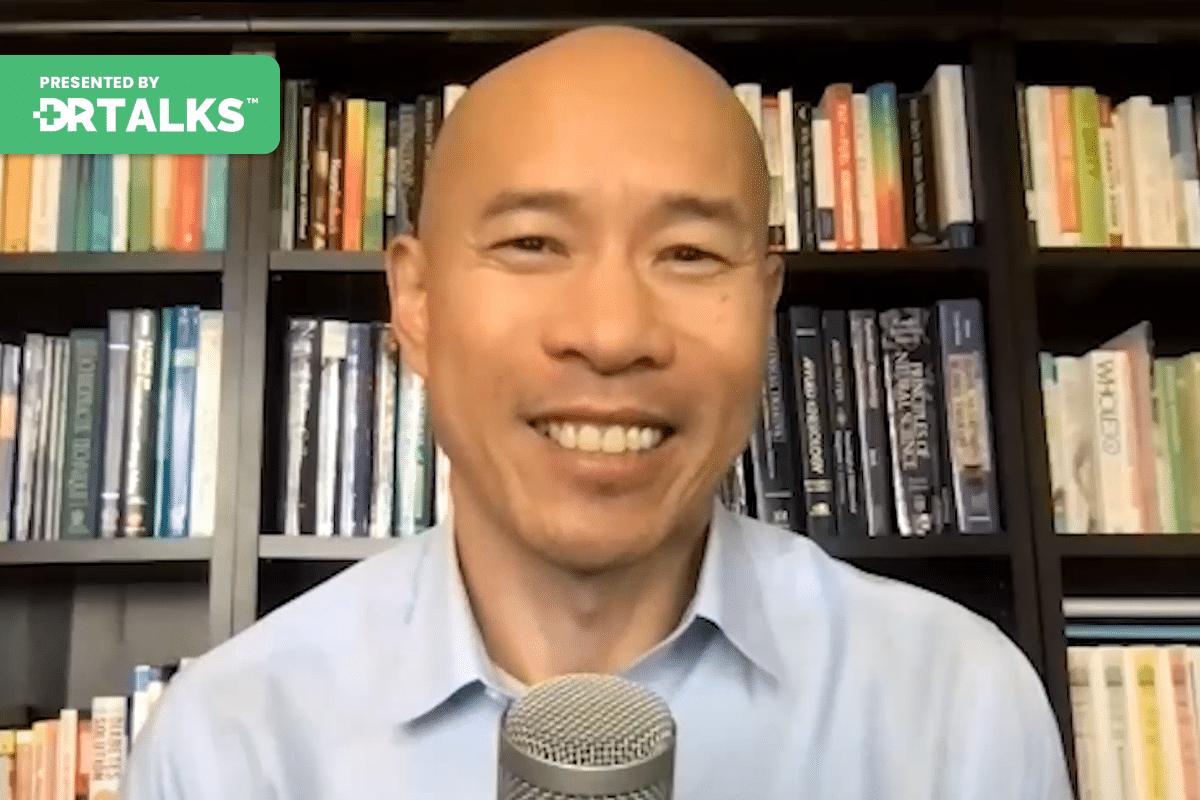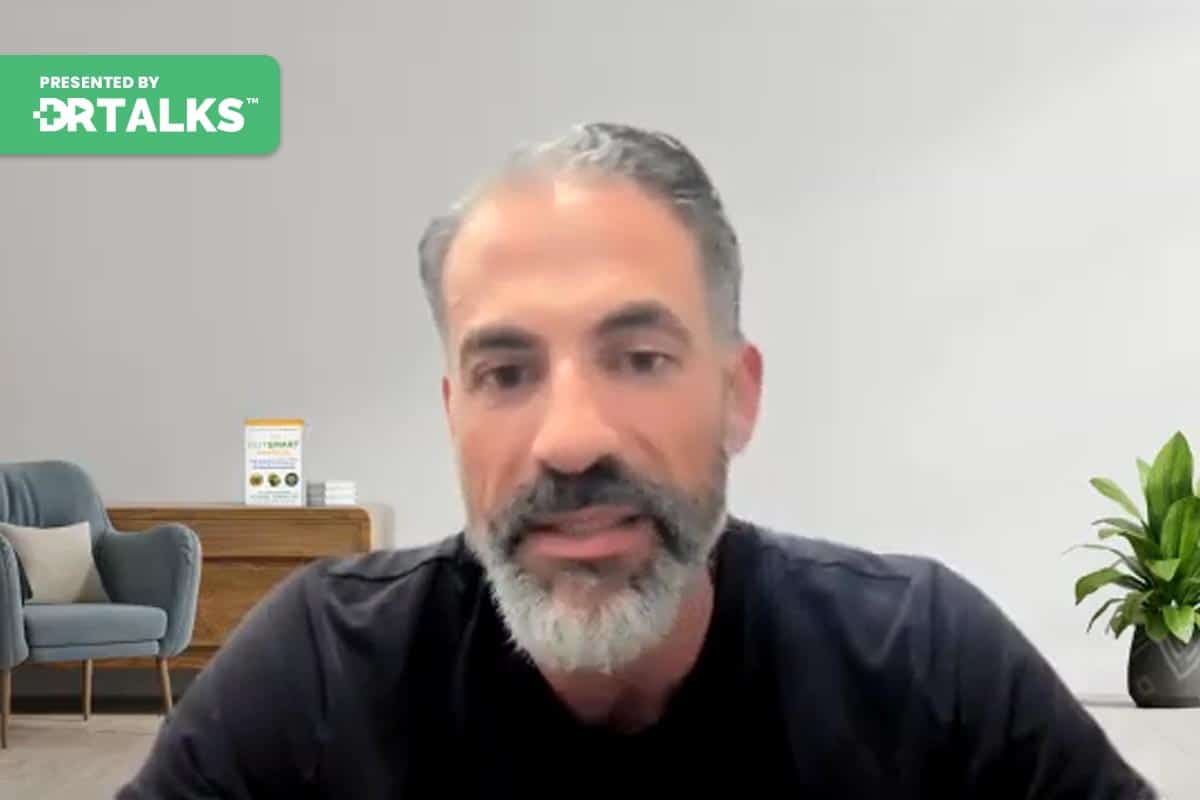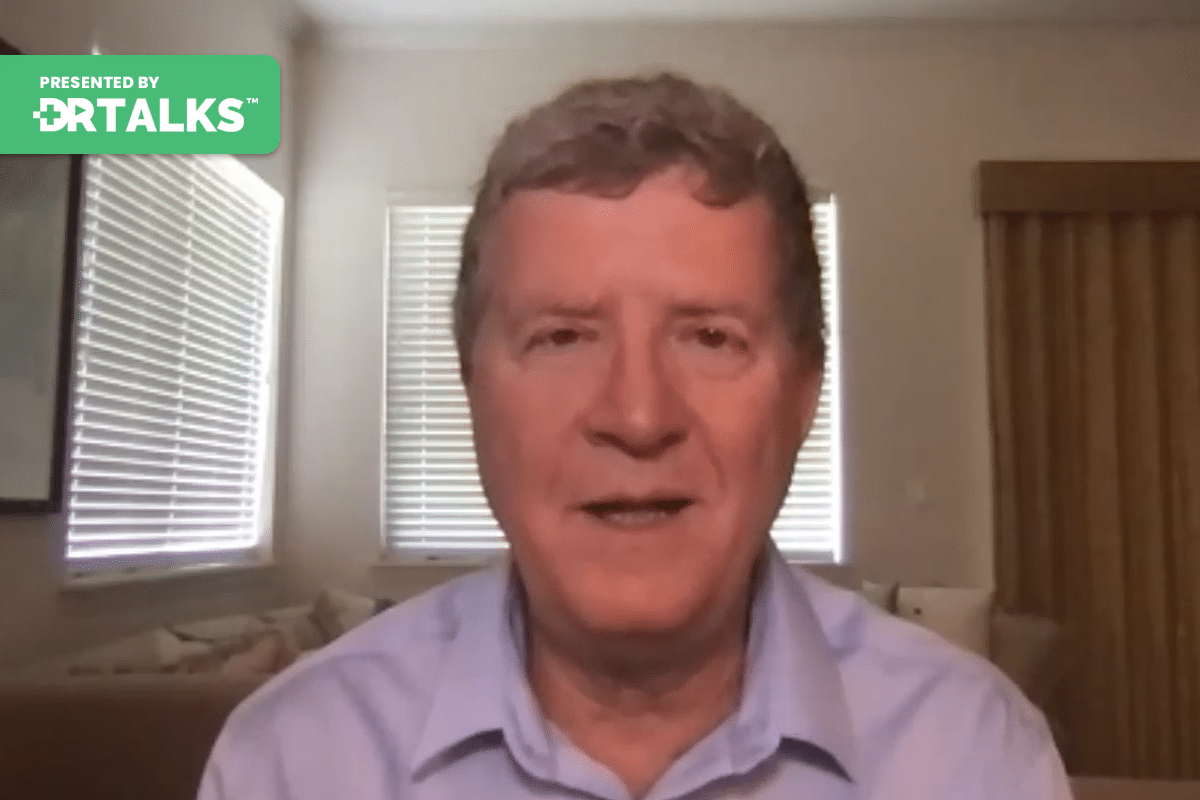Join the discussion below

Dr. Darin Ingels is a Licensed Naturopathic Doctor, Author, International Speaker, and leading authority on Lyme disease. He is a former Lyme patient who overcame his own 3-year battle with Lyme disease, after having failed conventional treatment and became progressively debilitated. Dr. Ingels found that proper diet, lifestyle management and... Read More

Peter Kan, DC, DACNB, FAAIM, CFMP, CGP
Dr. Kan supports and manages patients with chronic conditions using a comprehensive approach by merging the exciting advances of functional neurology and functional medicine. Dr. Kan is Board Certified in Integrative Medicine, Functional Medicine, and a Board Certified Chiropractic Neurologist. He is the creator of NeuroMetabolic Integration, a virtual functional... Read More
- Understand how the brain and the Vagus nerve control the gut and immune system
- Learn how fight or flight keeps you stuck
- Learn how toxins adversely affect your brain and gut and strategies to detoxify
Darin Ingels, ND
Welcome everyone to this episode of the Lyme Disease Summit. I’m joined today by my friend and colleague, Dr. Peter Kan. And before we get started, let me just give you a little bit of background about Dr. Kan. He is board certified in integrative medicine, functional medicine, and is a board certified chiropractic neurologist. Is the creator of the Neuro Metabolic Integration Program, a science based virtual online coaching program that identifies the root cause of autoimmune disease and other chronic conditions. And that includes something like Lyme disease. He’s treated thousands of clients all over the country and really one of our thought leaders in functional medicine. So, Dr. Kan, thank you so much for joining me today.
Peter Kan, DC, DACNB, FAAIM, CFMP, CGP
Thank you so much for having me. Dr. Ingles.
Darin Ingels, ND
You know, you and I have talked so much on different, you know, summits and podcast and you talk a lot about the same kind of issues, particularly as it relates to gut and brain health. Yet for people dealing with Lyme disease and chronic tick borne illness, this is so appropriate because this is often a Condon common, you know, underlying theme with these chronic infections is that there’s some element of disruption in the gut and the brain. You know, can you just start off and just kind of educate us a little bit about the connection between the gut and the brain?
Peter Kan, DC, DACNB, FAAIM, CFMP, CGP
Absolutely. And, you know, it’s no news now by now that there’s a brain. Gut connection or a gut brain connection. Depends on who you talk to. If you talk to the GI specialists people, they’re going to say that gut brain connection, if you talk to the brain guys, they’re going to say the brain gut connection. The reality is that it’s a bi directional communication superhighway, putting the brain in the gut and that that communication pathway is primarily done through the vagus nerve. Now, vagus nerve is a part of the parasympathetic nervous system, and within the parasympathetic nervous system you have a lot of different nerves mediate that function. For example, you have other cranial nerves like cranial nerve, three ocular motor nerve, which controls your pupillary constriction response. You have cranial nerve A7 that controls the, you know, the tearing response that’s also parasympathetic. So you have other centers that control percent parasympathetic, but none is bigger than the vagus nerve. In fact, about 90% of that parasympathetic output is really mediated by the vagus nerve between the brain and the gut specifically. Obviously, the vagus nerve also innervate the hard innervate lungs innervate other places, but the digestive tract is really where there’s a lot of branching of the vagus nerve into that area. So so we often talk about this brain gut connection as a nervous system type of control, right? The brain control, the gut motility to secretion, the valvular control, the finger sphincter control is all done through this neurological pathway. And then you have the afferent or signal coming from the gut, the enteric nervous system back up to the brain to communicate what’s going on in the gut through that pathway. Now, that’s the neurological connection.
But we also have a chemical, endocrine and immunological connection between the brain and the gut through various cytokines and through various and peptides that communicate information between the brain and the gut. So what we have here is a very intimate connection between brain function and the gut function. And because they’re so intimately connected, when one start to break down or have dysfunction, then you start to get breakdown and dysfunction in the other area as well. And this is why often when we see people with guts symptoms like chronic gas, bloating, reflux, heartburn, or they have SIBO or they have IBS, often time there’s a brain concomitant to it. People may experience brain fog, they may experience depression, anxiety. They may experience short term memory issues or lack of motivation. These seemingly neurotransmitter like symptoms can be involved with gut issues. And then you also have people with a brain sometimes, then also, conversely, have got a problem as well. So we want to look at these problems kind of cohesively and comprehensively because otherwise, you know, if people are just treating things from a metabolic or digestive standpoint and ignoring the brain component, then they may be missing a big piece of the puzzle where they could have, you know, got a lot of improvement.
Darin Ingels, ND
You know, I think this is one of the big problems with so many Lyme patients I work with. I guess it’s a little bit of the chicken and the egg thing, you know, which one begat the other because you can get Lyme affecting your brain again because of the brain fog and the headaches and the neuropathy and all the neurological symptoms we tend to see. But some of my line patients also have gastrointestinal problems, and we know you can get infection in the gut directly. So I guess, you know, we’re always kind of trying to sort out, you know, where is really kind of the root. Is it really stemming from the brain? Is it stemming from the gut? And I guess in reality, it really could be both, right?
Peter Kan, DC, DACNB, FAAIM, CFMP, CGP
It really can be both and really oftentimes is both. And then therefore, the treatment should be directed to both. So if you say someone with Lyme disease and the Lyme has gotten into brain and causing brain inflammation, or that brain inflammation that’s going to downstream cause digestive issues, because when you start to get decreased frequency of firing of your core or if your cortical function of your cortex, just remember we would talk about vagus nerve 90% of the cortical output of what your brain’s signal that’s going out to the rest of the body. 90% of that is going to parasympathetic is going through the vagus nerve. Only 10% of your cortical function is controlling other things like volitional muscle response and your thought processes. 90% is autonomic. So what that means is if you had decreased brain function due to brain inflammation from line or from concussion or from heavy metal toxicity, then you’re going to have decreased firing of your brain, which means downstream the vagus nerve received as signal from the cortex will also have decreased frequency of fire. And that’s going to cause gut problems. So it’s almost like you cannot fix one without fixing the other. And I think oftentimes the opportunities missed when people are not aware of that.
Darin Ingels, ND
Yeah, it seems like so many people get stuck in fight or flight. There’s this again, the sympathetic overload. And as you kind of alluded to, you know, so much of our normal body function happens when we’re in that relaxed parasympathetic state. So for people tuning in who are, you know, feel like they’re on the hamster wheel and they just can’t get off, you know, how do we best regulate that vagus nerve? How do we get ourselves out of that cycle? I mean, obviously, you know, treating the infection, if that’s part of the root cause, is going to help mitigate some of that. But do you have recommendations on what are other things people should be thinking about that’s going to help improve their vagal tone?
Peter Kan, DC, DACNB, FAAIM, CFMP, CGP
Absolutely. Yeah. I think that’s such a great question because in recent years there’s been a lot of interest in Vagus nerve. I think a lot of people have heard of the vagus nerve and kind of understand that, oh, vagus nerve innervate the gut, vagus nerve parasympathetic. So firefly’s the opposite. So how best to bring balance to that system? And I say balance, meaning it’s not that sympathetic fight or flight response is bad or is just is you know, it’s not that inflammation is bad is just that it’s part of our bodies. Normal yin and the yang. Right. Gas pedal, brake pedal. So for anything to function in the body, we have to have a way to, you know, facilitate or speed things up. And we have to have a way to inhibit it and bring it back down to homeostasis. So stress response or fight or flight response is not back in and of itself. Because if you have a deadline to me, you’re going to get on stage to perform. You have some kind of athletic event, you have some kind of something you need to accomplish in short term.
You want that stress response. The inability to summon a stress response is someone who’s really fatigued. Right. Adrenal fatigue or just they’re just always low energy and that’s not good either. So I want the audience to know that it’s not we don’t want to assign these judgment to these physiological function because they’re just normal function. The only problem comes when it’s shifted in one way or the other, and you can swing that pendulum back to back to normal or homeostasis. That’s one that’s a problem. So in thinking about how best to stimulate the parasympathetic or the vagus nerve, number one, I mentioned earlier, 90% of it comes from the brain. So I think so much talk is around how do we stimulate the vagus nerve? As if the vagus nerve is like this button that you push the easy button or guitar string, you can just pluck that vagus nerve. Ding, ding, ding, ding, ding. And the vagus nerve, which is come alive. And all your problem will be solved. That’s not that’s not probably the whole picture. There’s definitely these things you can do, specifically the vagus nerve, because vagus nerve has a motor component or innervate a lot of the muscles of swallowing the vocal muscles. So hence some of the things you can do for vagus nerve stimulation is literally throat exercises like humming and gargling and even gagging reflex.
Gagging yourself to induce a gag reflex is all going to cause that motor muscular contraction, which is going to be mediated by the motor component of the vagus nerve. But remember, 90% of the brain’s output goes to the vagus nerve. So presynaptic lee presynaptic means is the vagus nerve getting a signal from right. And the signal coming into the vagus nerve is already not good. Then the Vegas is not going to be able to fire. So we may want to think about improving vagus nerve function from the perspective of improving cortical function. So what does that practically mean? Well, if somebody has brain symptoms, then we will seek to improve those brain symptoms. For example, if they have brain fog that might indicate brain inflammation, that might indicate fuel delivery problems, then we’ll go and identify if there’s those problems and we solve for those problems. If somebody has short term memory issue, then that could also be a neuro inflammatory condition. But might there be a cortisol issue? Might there be hippocampal degeneration?
So then we go and identify those issues and solve for those issue. Is there a particularly more pattern of ward loss? And then so if you’re, you know, the words on the tip of your tongue, but you can spit it out. That may be left brain. Broca’s area, the Broca’s area, the left brain is where that language center is. So that’s why we have Broca’s aphasia. People with a left brain stroke and a Broca’s area right around here will have aphasia where they can speak. Now, if you have a lesser form less than a stroke, it just a difficulty or dysfunction in that area, then you can still get this word loss, just not a stroke. So that we may do very specific brain based therapy to address it. Of course, these are things that we can do to stimulate a certain area of the brain by understanding frontal lobe function if it’s right or left hemisphere. So that gets pretty detail. Probably want to work with a functional neurologist on that. But still though, what’s causing those area to dysfunction could be lying right?
Could be heavy metals, could be concussion, could be gluten sensitivity causing neurological inflammation could be leaky gut causing that bi directional communication and pathway so that you get leaky gut and you get leaky blood brain barrier. So it’s more about understanding what are the possibility have a mental model for what’s out there, what’s available so that if you’re if what you’re supposing or why your treatment plan doesn’t work, then you have a backup plan. You have an alternative route to still get there. And I think a lot of people, they just get so invested in one thing, you know, and you and I talked about Lyme, it’s all Lyme. Yeah, Lyme is bad, but what about metals? What about Mycotoxins? What about like if your blood sugar sucks, you’re diabetic. Would that compromise your immune system so that you can fight whatever it is as well? Would diabetics have compromised brain function? Therefore they have decreased cortical output. Therefore they can stimulate a vagus nerve. Therefore, downstream, the gut’s not working. And that’s going to impact the immune system because 70% of your immune systems. And so we can kind of just go on and on and on. But by understanding how they’re all connected, then I think give people a better mental map of the territory and they can navigate it better.
Darin Ingels, ND
Well, I really appreciate those comments because, again, I think people tend to hang their hat that everything they experience is just Lyme. And you know, they call a line the great imitator, the great mimic, of course. And there’s hundreds of symptoms associated with Lyme. But again, I think for people with any chronic illness, it doesn’t have to be just Lyme disease. There are so many other underlying factors that if you don’t address it, you’re never really going to get over the hump of dealing with, you know, chronic infection because your body’s susceptible in so many different ways, like I said, to heavy metals, to leaky gut, to elements of toxicity. So I really appreciate your whole body approach because again, we have to look at all these factors if we want to control all these aspects of things that are influencing your health and you know, whether it’s Lyme, Bartonella, Babesia, you know, take your pick. I think we know, you know, I’ve talked about this as well as like is it really the germ that’s the problem or is it the terrain? And I can’t emphasize this enough about, you know, how important the terrain is and being able to get well.
I mean, that was my own experience with Lyme disease. You know, again, I got infected. I had classic Lyme disease. I had all the classic symptoms. But, you know, I got bit two weeks before I opened my own business. And I was stressed out of my mind and I was doing all the work cause I couldn’t afford staff and I wasn’t sleeping well. I wasn’t eating well. I mean, looking back, it was the perfect storm of, you know, allowing that bug that I think I had probably at least dealt with initially allowed it to resurface because my immune system wasn’t as healthy as it should have been metabolically. I wasn’t as healthy as I should have been. So just to note that, you know, you’ve got to pay attention to all these different aspects. And if you’ve got a doctor who’s just solely focusing on killing the bug, you’re probably going to just be disappointed in the results.
Peter Kan, DC, DACNB, FAAIM, CFMP, CGP
Well, that’s why I appreciate your work so much, Dr. Ingles, because even though you’re the Lyme expert, you wrote books on Lyme, but you know you’re not stuck online, you’re talking about the terrain, you’re talking about other things that can be there that’s causing the Lyme to, to be able to reactivate or to, to exist. And, you know, and so I think it’s important for people to know that, yes, you can get acute, you know, Lyme, you know, Borrelia borreliosis from a tick bite and things like that. But I think, you know, as you alluded to in our previous talks that many people already have Borrelia they already have to take by before the organism is already in their body, but it’s just perhaps in a dormant state. And what happens is if your immune system’s not working properly, then it’s going to allow the virali or whatever other infection. And this is speaking of Lyme, but it could be Epstein-Barr virus, could be mycoplasma pneumonia, could be any other organism that has a tendency to kind of stay in a dormant stage and then it can reactivate because it’s opportunistic. Is taking the chance that your immune system is off guard. So then this is a chance for them to grow back. So I think reminding, you know, understanding immune system in a much more nuanced way and understanding what’s impacting that such as the terrain and stress and all of that is probably the best route for anybody to go through because then even if it’s not Lyme, whatever condition you’re dealing with your, you’re a sure to be addressing the terrain issue, which is the foundational issue, I believe.
Darin Ingels, ND
Absolutely. And I think that sort of Segways into toxicity. You know, I think if you get down to our most basic cellular level, it’s this element of toxicity that’s altering normal cell function. So if you’ve got a damaged neuron or a damaged gut cell and you want that to repair itself, look, you know, it’s built into your DNA to heal, right? I mean, you know, if you cut your finger, you don’t have to tell it to heal. It knows what to do to form a clot and then make new skin. And eventually, you know, it heals, you know, and fortunately for all of our tissue, that process is in place. Now, granted, there are very rare circumstances. I mean, you suffer spinal cord, at least a date that may not be irreparable, but pretty much other issues that people are dealing with are fixable. If you give the body the right circumstances and set the stage that that can happen. So I want to talk a bit words about toxicity. You know, what are you seeing in your work and your practice of being? You know, you mentioned heavy metals. Are there are other things that people need to be aware of that could be these sort of unknown toxins that are undermining their health.
Peter Kan, DC, DACNB, FAAIM, CFMP, CGP
Yeah, I think, you know, that’s interesting. You know, unknown toxins. I think it’s unknown to them, but it’s not unknown to the scientific community and public health officials because we have multiple mechanisms that they’re tracking these things like a hawk. Right. We actually know quite a bit about these toxins and what it’s doing to our population and what type of disease characteristic is causing. We actually know quite a bit about them. The general public doesn’t know about them because it’s not portrayed on the news all the time, because I think most of the mainstream TV, it’s all sponsored and bought by commercials by the food industry and a very players that that are selling these chemicals that that that’s kind of causing the problem so we don’t we don’t hear it in the mainstream press but definitely in a scientific community, just do a simple PubMed search or even Google search. You’re going to see tons of information article about how pervasive the toxin is. So, you know, so these things include heavy metals.
These things include pesticides, herbicides. Those are some of the herbicides. And pesticides are very common because people think that it just comes from, oh, you know, organics, I can have them. But really, even among people who eat organic, I still see quite often that have very high levels of herbicide and pesticide reasons because it’s in groundwater. You can also inhale it most of the time is actually to inhalation. You know, your neighbor, you know, sprayed air or the park across from you to golf course sprays. I mean, basically, the golf course is just like one giant cloud of pesticide cloud, you know, when they spray. So that you don’t expect that to just stay there, right. If it’s an air, it’s going to blow around. The wind blows in mixing, you know, you’re just breathing it. So a lot of people have those type of issue. And in plastics, very common fire retardant material, very common. So there’s a lot of these chemical that are you know, we say unknown. I think just more people are under aware how much there are getting opposed to. And of course, there is also mycotoxins from mold, which is again, just it’s everywhere is in the air. You know, you don’t have to have a damaged building to have michael toxin exposure. But I think the biggest thing about toxins in my mind is that I don’t want people to live scared, you know, because certainly everybody’s exposed are like, okay, what do we do then? Yeah, the incidence of disease is skyrocketing.
A lot of it could be associated with toxins, but certainly there’s also people walking around that have some level of a toxin and they’re doing just fine. Right. I mean, because if you do population studies, probably every one of us has metal, some level of metals, every one of us has some level of some junk in our body. But some people are doing just fine. And other people, they’re so chemically sensitive, they can’t even handle innocuous, tiny amount that other people can handle just fine or even themselves. Maybe five years ago they were okay and now they’re not okay. So they basically develop a sensitivity due to various other brain issues, either genetic problems or they’ve been exposed for so long, or the combination of things that are exposed to that’s weakened their immune system that caused them to have these infections that they can clear, then that starts create this know really immune system imbalance. That’s one tissue dominance issue and then nasal to drive this brain immune gut problem, which is often the central piece that I see is causing the brain gut connection problem is really the immune system problem that’s how I see it.
Okay. A lot of times you say all disease begins in the gut. Yeah, it begins in the gut but begins with the immune system that’s in the gut. Right. So all of it is really just giant communication networks between all these immune cells. But there’s these vicious cycles that you can get into where your immune system just gets stuck in one way or the other. Either you can fight off infections or you’re chronically inflamed or you’re chronically making antibody to something, which means that you’re chronically sensitive to the environment. And that all drives your immune system into this disarray where you’re chronically infected and you’re chronically inflamed, which is a bad situation. And so people just they get stuck and that’s why they don’t feel good. And then they’re searching for answers to maybe, oh, I got to be detox. Got to be detox. It’s got to be the more or it’s got to be the line. Well, it’s probably all of those. But underneath it all is this immune dysfunction. So I see balancing immune system is really a big part of what I do now, even though, yes, the gut and the brain. But we cannot leave that immune system part out of it also.
Darin Ingels, ND
So do you have specific detox strategies that you recommend for people you work with? Because again, I would argue that anyone with chronic Lyme chronic infection and chronic illness is toxic to a certain degree. And whether that’s genetic that you’re just too poor to talk sapphire again, we see this all the time with mold. You can have five people living in a house. One or two people are affected. The other people don’t get bothered at all. So we have, you know, varying degrees to which we’re able to eliminate various toxins. And, you know, you read so much about detox. And unfortunately, I think there’s a lot of really bad information on, you know, detox. I’m honest personally, I’m not really in the camp of though the three day, five day detox. You know, let’s just, you know, like wring out a sponge is going to get rid of all the toxins. The reality is, is you live on planet Earth in 2023. It’s in a toxic world. There’s literally no place in the world you can go that’s free of toxins. So knowing that this is an ongoing exposure, you know, detoxification really becomes an ongoing thing. You’re like always kind of doing it and there’s more things you can do or things you can do, not necessarily every day. But I think people need to be thinking about it, that this is a long term problem. Your whole life kind of strategy, and it’s not just going to be a quick one and done kind of thing. So what are some recommendations you can give to the audience on the ways that they can help detoxify to improve their health?
Peter Kan, DC, DACNB, FAAIM, CFMP, CGP
Yeah, I think that’s a great point. Actually, Engel’s detox is more of a lifestyle. You know, detox is now something you do, oh, you know, New Years I’ve been bad for Christmas mean it’s just like nothing for seven days and lose 10 pound. Detox is not one of those things. So that’s why a lot of time people when they asked me question Dr. Khan, what supplement can I take for detox? You know, what can I do for liver flush or kidney flush? Like, what does that mean? You know, to me, it’s kind of a just a slang turn us strong stone realm that may or may not have a lot of, you know, basis in like utility or reality that they can expect some degree of improvement. You might hear some anecdotal stories, but I think for most people, detoxification is best, best done as a lifestyle. Right. So what are some of the lifestyle things that people can do? And I like lifestyle because that means that there’s something you can do on a habitual daily basis.
It’s not something you have to like go and you know, I’ll buy like ten supplements to detox for short periods of time. So, so detox really. For me, some of the practice will be like number one is exercise. I mean I think is the most underutilized tool is certainly not talked about enough in functional medicine in our world. Right in the summit world, a lot of talk is about, yeah, detox. You got to take the binder. You take glucose iron. Yes. But if you’re not exercising, you’re kind of missing out on a whole swaths of territory that you could be gobbling up when it comes to detox. Sana, I think is great. I’m a big fan of sauna sweating. I just moved to Arizona in the summer and just stand outside. You got one so it’s free. But yeah, certainly infrared sauna for home is great too. There’s just so much evidence. And, you know, from a scientific perspective that stack enough for sauna that I’m just becoming a big fan of hydration, you know, some of the basic stuff, right? But I think some of the overlooked daily strategies for detox is really just foundations for what I call neuro metabolic health. You know, neuro metabolic means, you know, how your brain and your metabolism coordinate to kind of create this healthy function, salt metabolism. Then one of the big things that I talk about is blood sugar, stability. And if your blood sugar is not stable, it makes it very difficult for you to have mitochondria function and produce energy steadily. Very difficult for you to make neurotransmitter. And I’ll say it’s even difficult for you to detox.
By the way, one of the phase two detox pathway in the liver is glucagon, sedation and Gukurahundi shown as a pathway that requires blood sugar stability. You know the word glucagon, sedation, glucose, it’s kind of like the prefix for that for that particular detox pathway. So it just tells you how important blood sugar stability is. We have blood sugar instability. A source of your B vitamins and B vitamins turned out to be very important as cofactors for detox. So to me, I think, you know, that the foundational things that people can do every day is eating well, exercise, eat in a way that promote blood sugar, stability, right? Get your metabolism in, check, hydrate and you know, do the sauna, do the sweating. I think those are like just tackling and blocking things that people can do to just set up the foundation so that they do decide to do more aggressive detox that may be able to, you know, do it with flying colors.
Darin Ingels, ND
Well, I think we saw so much during the COVID pandemic about how important being metabolically fit was. And we know the people. I think I read less than six or 8% of Americans are metabolically fit, which is abysmal. But that also sets the stage for chronic infections. So if you’ve been dealing with Lyme and you are not metabolically fit, your disposition is, you know, you’re a little bit behind the eight ball. So I like the low hanging fruit exercise. A huge fan of sauna as well. It’s amazing how much junk your body can get rid of, you know, when you do sauna and you know, consider and I talk about this all the time, you know, that the average American gets exposed over 80,000 chemicals a year and less than 200 of them have actually been studied for their safety. So we’re all kind of guinea pigs out there on our toxic exposure with really very little understanding on how it’s influencing our health. And you know, we’ve talked with other speakers in the summit as well about the importance of, you know, cleaning up your home and getting rid of, you know, chemicals around the home.
And that includes what you put in your shampoo and makeup and conditioner and sunscreen. Everything you put on a skin is potentially another toxin. And honestly, it’s one of these rabbit holes that you can keep going down and feel like you’re never going to get to the bottom of it. But the fact that there is so much you can control at home so many things you can do that don’t cost a lot of money, that might take a little bit of time and effort. But for most people, that’s doable. And I think sometimes we get so caught up in the high tech stuff, especially with Lyme disease. I mean, I have people flying all over the world spending thousands and thousands of dollars on whatever the therapy is and the hopes that that’s going to be the thing that moves the needle. But if you haven’t done all this other foundational work again, I think you’re going to be disappointed. That’s been my clinical experience and people go to Germany to do hypothermia and they do stem cells and these are all great therapies for the right person. But again, without the foundational work in place, it just tends to be very disappointing.
Peter Kan, DC, DACNB, FAAIM, CFMP, CGP
I totally agree. I think, you know, there’s a tendency for people to kind of go after like the newest and the freshest, you know, the shiny object syndrome, I think. And this is why I talk so much about doing the foundational stuff, which is really what functional medicine is. And not to say that there’s not somebody where they do, just toxicity is the main driver. They have so much of a they’re acute and then so then doing a detox can really just kind of relieve some that burden. Same thing with infections. You have chronic infection, you give some antimicrobials or even an antibiotic. In some cases it just kind of exogenous early help to knock some of those burden down so your immune system doesn’t have to fight it on its own. It can be very helpful. But at the end of the day, though, if you know you have poor circulation, you’re anemic, your blood sugar sucks, your stress out of your mind, your guts not working, you’re inflamed, you’re toxic. Probably it’s not going to work that great even if you do whatever therapy that you’re doing, you know.
Darin Ingels, ND
Yeah. Now it’s. Well, I said it’s a very difficult thing. And just because we all have so much exposure, none of us can get away from it. But again, I just want to empower people listening that there is so much you can do. There’s a lot of great resource sources out there on cleaning up your home, cleaning up your environment. I said go for the low hanging fruit first and then you can start working into more advanced kind of therapies. I want to talk a little bit too about hormones. You know, we’ve got this relationship between our nervous system, our immune system and our endocrine system. Can you share a little bit about what your experience has been on, you know, how do hormones fit in this whole conglomeration of, you know, Lyme disease.
Peter Kan, DC, DACNB, FAAIM, CFMP, CGP
Hormone fits in quite a bit in chronic illness, including Lyme disease. You know, there’s a whole field of neuroendocrine immunology, right? Neuro means brain, endocrine hormone immunology, how that impacts immune function. So by way of stress, that’s one pathway where people can sort of altering their hormonal status and then sort of having an impact on their immune system. So we can have stress and sort of so also our adrenal function by overproducing stress, hormones, cortisol and so forth. And then you may end up with high cortisol, you may end up with low cortisol depends on the degree and severity of it. And that’s all going to impact your immune function and also impact your metabolism, right? Because your cortisol is going to really have a big role in regulating blood sugar and that’s also going to have a role in impacting your nervous system, because the cortisol is going to have some feedback loop within that sympathetic nervous system as well. So so that’s adrenal hormone. Now, thyroid hormone played just as big a role in, you know, immune function as well. We know that low thyroid function can cause your micro glial cells to actually activate. So if you get overactivation the micro glial cells, you’re more likely to have brain inflammation and brain damage from that. So then if you already have Lyme disease that’s burrowed into the brain, you already have neuroinflammation as a result of Lyme or whatever other reason. Then having this type of, you know, hormonal issue like low thyroid can cause that brain inflammation to actually get worse.
So definitely there’s a thyroid immune access where low thyroid function is going to cause more inflammation. And then we have the sex hormones as well. You know, estrogen and testosterone, each for male and female have, you know, a slightly different role. Like testosterone is very cardioprotective for the male, while estrogen is very cardioprotective for the female. Some of this is cardioprotective because it has a role in dampening inflammation, in fact, for females when they become menopause and they have low estrogen levels and then usually they associate, you know, menopause with osteoporosis, the reason females tend to become more osteoporotic as they age is because low estrogen actually makes it so that you can dampen inflammation as well. And then so therefore, that inflammation is causing the osteo activity to increase. So there’s actually a inflammatory model of osteoporosis. In fact, in the literature is called Immunol process.
That’s what they’re calling it. Now that there’s so much evidence showing that osteoporosis in its inflammatory condition, they’re starting to call it something else, immuno paralysis and the estrogen has a immune system dampening effect in females, so that if you lose that, then you become more inflamed, which there’s a pathway, there’s a specific pathway where the more you become inflamed, the more your innate immunity gets suppressed, which means that you can’t fight off infection. So that allows Lyme and other opportunistic pathogens like Epstein-Barr and Mycoplasma to start to express themselves. So now you have this chronic infection that you can clear, and this is why people are stuck that way. So hormones, we need to minded, we need to mind the brain, we need to mind a gut. When you look at toxins and I will say one more thing, Dr. Ingles, is that this is a little bit esoteric, but we talk about toxins. But don’t forget about the mental toxins, right? Mental toxicity. People have negative self-talk like, you know, just all the negative or negative influences from just watching the news, right? So whatever we feed our brain, if it’s toxic or we have toxic relationships, I think that also is going to have a toxic effect on our body. You know, like creating stress response and stress response will have downstream, you know, neuroendocrine issues associated with that. So I think detoxing. Absolutely. That means have pure mind, pure, pure body. Right. And then there’s all this practice that, you know, people can do to help with that.
Darin Ingels, ND
Now, that’s great advice. Again, it’s just I love the fact that you’ve got so many great suggestions and tools for people to do and yeah, we didn’t really get into the trauma part. I think that’s another toxin, another factor. And I know we’ve got other speakers on the summit that are specifically addressing that. But again, this is a whole body approach to dealing with Lyme disease. You know, this has been such a great talk reader. You always have great information. If people are interested in wanting to learn more about your work with you, where’s the best place for them to find?
Peter Kan, DC, DACNB, FAAIM, CFMP, CGP
You know? Thanks. Thank you so much for letting me share. So yeah, they can find me on YouTube. I have a lot of free content on YouTube, so just go to YouTube, type in Dr. Peter Kan, the ball head. A Chinese guy will pop up pretty easy to find. And then also on my website is ask Dr. Comcast. There’s helpful information on our approach. So those are great places to find me.
Darin Ingels, ND
Peter, always a pleasure. Thank you so much for joining me and offering great knowledge to the community.
Peter Kan, DC, DACNB, FAAIM, CFMP, CGP
Thank you for having me is a pleasure.
Downloads










